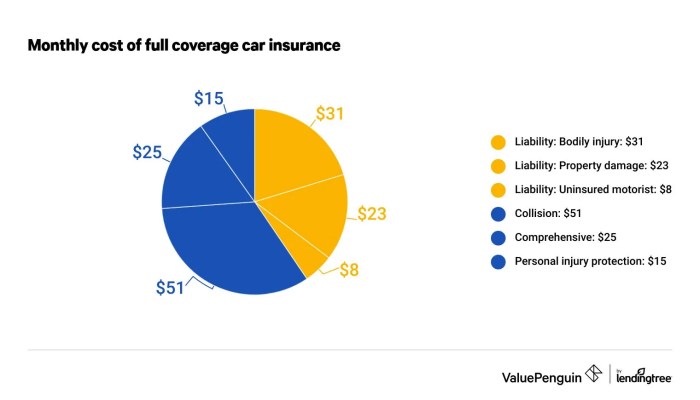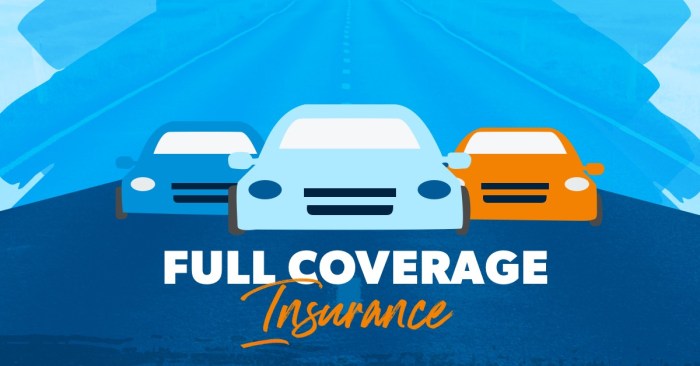
Full coverage insurance opens the door to a comprehensive understanding of insurance protection, delving into the nuances that differentiate it from other types of coverage. This article aims to shed light on the intricacies of full coverage insurance, offering readers a detailed exploration that is both informative and engaging.
As we delve deeper into the realm of insurance coverage, we uncover a wealth of information that will guide you through the complexities of full coverage insurance.
What is Full Coverage Insurance?
Full coverage insurance is a type of auto insurance policy that includes both liability coverage and coverage for damage to your own vehicle. It typically consists of collision coverage, which pays for repairs or replacement of your car in case of an accident, and comprehensive coverage, which covers damages from events like theft, vandalism, or natural disasters.
Difference Between Full Coverage and Liability-Only Insurance
Liability-only insurance, on the other hand, only covers damages and injuries you cause to others in an accident. It does not provide any coverage for your own vehicle. Full coverage insurance, while more expensive, offers more comprehensive protection for both you and your car.
Importance of Having Full Coverage Insurance
- Full coverage insurance provides peace of mind knowing that your vehicle is protected in various situations, not just accidents.
- It can help you avoid significant out-of-pocket expenses for repairs or replacements in case of unexpected events.
- Having full coverage can also be required by lenders if you have an auto loan or lease.
Examples of Situations Where Full Coverage Insurance is Beneficial
- Scenario 1: Your car is parked outside and gets damaged by a hailstorm. Comprehensive coverage under full coverage insurance would cover the cost of repairs.
- Scenario 2: You are involved in an at-fault accident that damages both your car and the other driver's vehicle. Collision coverage in full coverage insurance would cover repairs for both vehicles.
- Scenario 3: Your car is stolen and never recovered. Comprehensive coverage in full coverage insurance would compensate you for the value of the stolen vehicle.
Types of Coverage in Full Coverage Insurance

When it comes to full coverage insurance, there are several types of coverage included to provide comprehensive protection for your vehicle and finances.
Comprehensive Coverage
Comprehensive coverage helps protect your vehicle from non-collision incidents such as theft, vandalism, natural disasters, or falling objects. This type of coverage can help repair or replace your car if it is damaged in any of these situations.
Collision Coverage
Collision coverage, on the other hand, helps pay for repairs or replacement of your vehicle if it is damaged in a collision with another vehicle or object. This coverage is especially important if you are at fault in an accident.
Uninsured/Underinsured Motorist Coverage
Uninsured/underinsured motorist coverage steps in to cover your medical expenses and damages if you are involved in an accident with a driver who does not have insurance or does not have enough insurance to cover your costs. This type of coverage provides peace of mind knowing that you are protected even if the other driver is not adequately insured.
Factors Affecting Full Coverage Insurance Rates
When it comes to determining the rates for full coverage insurance, insurance companies take various factors into account to assess the risk associated with insuring a particular individual or vehicle. These factors ultimately influence the premiums charged for full coverage insurance policies.
Age
Age is a significant factor that insurance companies consider when setting full coverage insurance rates. Younger drivers, especially teenagers, are typically charged higher premiums due to their lack of driving experience and higher likelihood of being involved in accidents. On the other hand, older drivers may receive lower rates because they are considered more experienced and less risky.
Driving Record
The driving record of an individual plays a crucial role in determining full coverage insurance rates. A history of traffic violations, accidents, or DUI convictions can lead to higher premiums as it indicates a higher risk of future claims. Conversely, a clean driving record with no incidents can result in lower insurance rates as it suggests a lower risk of accidents.
Location
The location where a vehicle is primarily driven also affects full coverage insurance rates. Urban areas with higher traffic congestion and crime rates may lead to higher premiums compared to rural areas with lower risk factors. Additionally, regions prone to severe weather conditions or high rates of vehicle theft may result in increased insurance costs.
Type of Vehicle
The type of vehicle being insured is another key factor in determining full coverage insurance rates. Expensive and high-performance vehicles typically come with higher premiums due to the increased cost of repairs or replacement in case of damage. On the other hand, safe and reliable vehicles with advanced safety features may qualify for lower insurance rates.
Deductible Amounts
The deductible amount chosen by the policyholder can impact the cost of full coverage insurance. A higher deductible means that the policyholder is willing to pay more out of pocket in the event of a claim, which can result in lower premiums.
Conversely, a lower deductible leads to higher premiums since the insurance company would be responsible for a larger portion of the claim amount.
Benefits and Drawbacks of Full Coverage Insurance

When it comes to full coverage insurance, there are several advantages and drawbacks to consider before making a decision. Understanding these can help you maximize the benefits of having full coverage insurance while being aware of its limitations.
Advantages of Full Coverage Insurance
- Comprehensive Protection: Full coverage insurance typically includes both collision and comprehensive coverage, providing you with financial protection in various situations such as accidents, theft, vandalism, and natural disasters.
- Potential Lower Out-of-Pocket Costs: With full coverage insurance, you may have lower out-of-pocket costs in the event of an accident compared to having only liability insurance.
- Possible Rental Car Coverage: Some full coverage policies include coverage for rental cars, which can be beneficial if your car is being repaired after an accident.
- Peace of Mind: Knowing that you have extensive coverage can give you peace of mind while driving, especially in high-risk situations.
Drawbacks of Full Coverage Insurance
- Higher Premiums: Full coverage insurance tends to have higher premiums compared to basic liability coverage, which can increase your overall insurance costs.
- Deductibles: Full coverage insurance often comes with deductibles that you need to pay before your insurance kicks in, which can be a financial burden in the event of a claim.
- Potential Over-Insurance: In some cases, full coverage insurance may provide more coverage than you actually need, leading to unnecessary expenses.
Tips for Maximizing the Benefits of Full Coverage Insurance
- Review Your Coverage Regularly: Make sure to review your full coverage insurance policy regularly to ensure that you have the right amount of coverage for your needs.
- Consider Increasing Deductibles: If you can afford higher deductibles, consider increasing them to lower your premiums while still maintaining adequate coverage.
- Bundle Your Policies: Bundling your home and auto insurance policies with the same provider can often lead to discounts on your premiums.
- Take Advantage of Discounts: Many insurance companies offer discounts for safe driving habits, installing safety features in your car, or being a loyal customer. Take advantage of these to lower your insurance costs.
Outcome Summary
In conclusion, full coverage insurance stands as a robust safeguard against unforeseen events, providing a safety net for policyholders in times of need. This comprehensive coverage offers peace of mind and financial protection, ensuring that you are prepared for whatever the road ahead may bring.
Quick FAQs
What does full coverage insurance include?
Full coverage insurance typically includes liability, collision, and comprehensive coverage, offering a wide range of protection for policyholders.
Is full coverage insurance more expensive than liability-only insurance?
Yes, full coverage insurance tends to be more expensive due to the broader scope of protection it provides compared to liability-only insurance.
Can full coverage insurance help in situations where my car is damaged by a natural disaster?
Yes, comprehensive coverage under full coverage insurance can help cover damages caused by natural disasters such as floods or storms.














